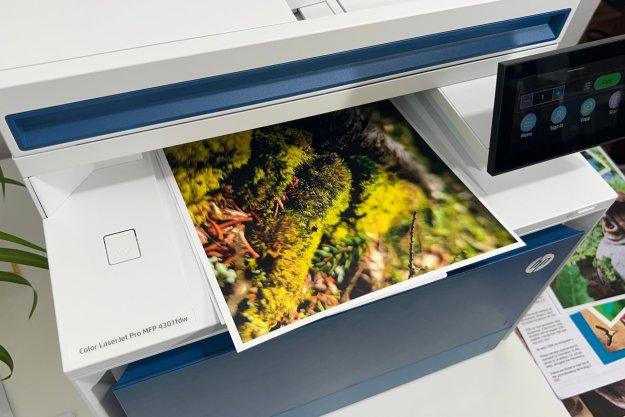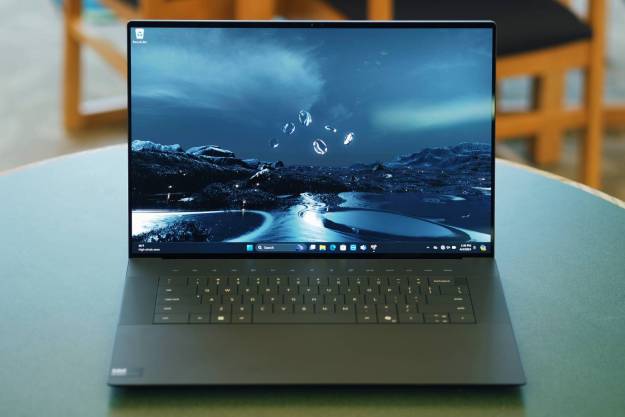“Machines don't come much sexier than this sultry and ultra-slim notebook, but are good looks really worth the $2,000-plus price?”
- Seductively slim; gorgeous aluminum and glass motif; decent performer (as ultra-thins go).
- Pricey; dearth of ports and no optical drive; battery not replaceable by user.
Summary
With a chassis measuring just 0.76 inches at its crest and an innovative unibody design, Apple’s MacBook Air broke ground in the high-end, ultra-slim, and super-refined laptop category at the beginning of 2008. Half a year later, HP’s Voodoo unit took things a step further via the Envy, a carbon fiber-covered siren of a machine with high-end hardware features—such as a touch pad that switches itself off whenever the user begins typing—and a girth even less than that of Apple’s couture machine.
And now Dell’s Adamo has claimed the coveted “Svelte Belt” for itself. Measuring a mere 0.65 inches at its portliest point, the system sports fine glass accents and brushed aluminum lines that will drive most tech fetishists mad with desire. It doesn’t offer much in the way of functional innovation—save perhaps its surprisingly agile, low-voltage processor—but the Adamo’s unabashed and undeniable sexiness ought to be enough to pique the curiosity of even the most jaded gadget aficionado.

It’s been said that beauty is in the eye of the beholder, but we would call into question the aesthetic sensibilities of anyone who doesn’t pronounce the Adamo to be strikingly gorgeous.
Dell’s new notebook features a chassis made of anodized aluminum that is free of visible screws and feels both cool and sturdy to the touch. The bottom of the machine is disconcertingly smooth and uncluttered, featuring naught but a metal plate with a couple of licensed logos (in lieu of the colorful stickers usually found below the keyboard) and a quartet of thin rubber feet. Its narrow edges are free of jacks, save a discreet headphone input on the right side and a sextet of ports geometrically centered on the back.

The lid, meanwhile, is composed of the same metal as the base plus a sheet of thin glass embedded on the top half of the outer shell. A pair of small logos—“Dell” and “Adamo”—have been pressed into the aluminum at the midway point. The screen underneath is a crisp and clear 13.4-inch WLED (1366 x 768 pixels) with a glass bezel that runs right up to the lid’s edges. The hinge is located about an inch from the edge, of the base, leaving a small precipice covered in tiny holes, a few of which act as an escape for sound waves emanating from the Adamo’s stereo speakers.
Open or shut, the Adamo has a feeling of solidity unmatched by its ultra-slim competitors—though perhaps this ought not to be a shock, since, at just over four pounds, it weighs about 30% more than either the MacBook Air or Voodoo Envy. Add to the sturdiness an almost complete lack of audible mechanisms (the solid state drive and low-voltage processor are fan-free) and suddenly you have something that looks and feels like a slab of brushed metal and glass but magically functions as a working computer. It’s a wonderfully appealing illusion.
The final flourish is a cleverly designed power cord with an adapter that’s just as slim as the laptop and features a removable plug, allowing for an extension cable to be connected in times when you need a bit more wire to reach an outlet.

Clearly, Dell’s new notebook is an exercise in high style, but it’s also a fine performer—assuming, that is, you’re not looking to do much more than edit documents, surf the Web, and watch a little multimedia.
The Adamo is available in two configurations, one priced at $1,999, another at $2,699, with differences coming primarily in speed and storage. We were provided the upper-tier version for our evaluation, and it sported a low-power 1.4 GHz Intel Core 2 Duo processor, four gigs of dual-channel DDR3 memory, and a 128 GB solid-state drive. It runs on the 64-bit version of Microsoft’s Windows Vista Home Premium operating system. The cheaper edition sees cuts to three key components: RAM and storage are both halved (ending up at 2 GB and 64 GB, respectively), and processor speed is bumped down to 1.2 GHz. Both editions offer the same Intel 4 Series Express integrated graphics chipset.
Lacking from the Adamo’s specifications is any sort of optical disc drive. That means folks hoping to install disc-based applications or watch movies will need to pick up an external unit. Dell offers a matching DVD drive that will run you $120 and a Blu-ray tray that sells for $350.
Skeptics and the non-style-minded will likely view the Adamo as little more than a blue-blooded netbook. That’s a fair assessment to a degree, as it certainly performs the same function, but our casual testing established the Adamo to be not only speedier, but also a far better multitasker than any netbook we’ve tried. Microsoft’s bulky Vista OS was handled with aplomb; applications opened and closed in a jiffy even when several others were already up and running; and neither Web- nor disk-based video ever staggered. Intensive graphics applications are out of the question, to be sure, but regarded as a purely web-surfing, document-editing machine, there is little about the Adamo with which one can justly take issue.
Ports and Connectivity
The Adamo’s body might be sleeker than silk on a supermodel, but it’s not without cost. You’ll likely begin noticing its limitations when you start trying to plug peripherals into its scaled-down connectivity suite, which includes a couple of USB ports, a USB/eSATA combo jack, a DisplayPort output, and a headphone jack. There’s also an Ethernet port, as well as support for Wireless-N and Bluetooth 2.1. Dell offers mobile broadband as an option for folks who need to hop online wherever they may be.
This jack pack will appease the majority of most users’ everyday needs, but the lack of HDMI, FireWire, ExpressCard, dial-up modem, and memory card ports will undoubtedly frustrate users with more eclectic needs.

Battery
Another of the downsides to the Adamo’s gorgeous chassis is that it’s nigh impossible to get inside, one of the consequences of which is that users cannot replace the battery. Dell’s happy to do it for you, but you’ll need to send your notebook back to them to make it so, sure to cause unnecessary grief should the need ever arise.
The good news is that it ought to take a while for users to wear the Adamo’s robust little power-packer down. We managed to get just over four hours out of it while surfing the Web, editing documents, and listening to a bit of music, all with screen brightness set almost at maximum.

The Adamo is first and foremost a work of industrial art. Dell haters and Apple enthusiasts will likely write it off as so much Round Rock, Texas hooey, but never before have we seen a machine elicit the sort of envious, drooling stares unconsciously displayed by our tech-loving colleagues when they caught wind of this dazzling little laptop. And it’s a very decent performer to boot (at least as far as ultra-thin notebooks go).
Still, when one considers the system’s dearth of ports, missing optical drive, and non-user-replaceable battery, there’s no getting around the fact the Adamo will be used by most people as a second computer—perhaps even as a second notebook.
Furthermore, with such a steep price tag, the Adamo is clearly a luxury purchase – a netbook for corporate bigwigs and wealthy technology lovers. One can’t help but question the prudence of releasing such a product during a period of financial turmoil that is keeping many of us from spending money on anything but the bare necessities.
All of that said, who are we kidding? If we suddenly had a paycheck to burn, it might well find itself spent on this über-chic and almost ridiculously desirable piece of technology.
Pros:
- Seductively slim
- Gorgeous aluminum and glass motif
- Decent performer, as ultra-thins go
Cons:
- Pricey
- Dearth of ports and no optical drive
- Battery not replaceable by user
Editors' Recommendations
- The 10 best monitors for 2024: tested and reviewed
- 9 best 2-in-1 laptops in 2024: tested and reviewed
- 9 best processors for PC gaming: tested and reviewed
- Best 14-inch laptops for 2024: tested and reviewed
- 10 best gaming monitors of 2024: tested and reviewed





